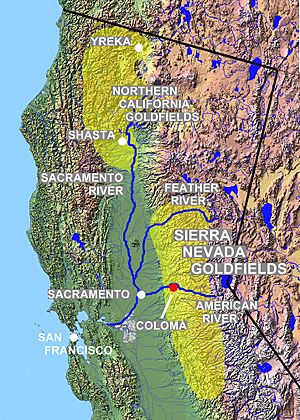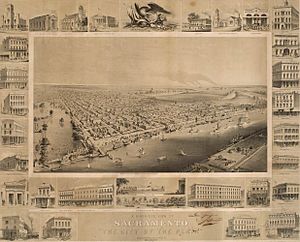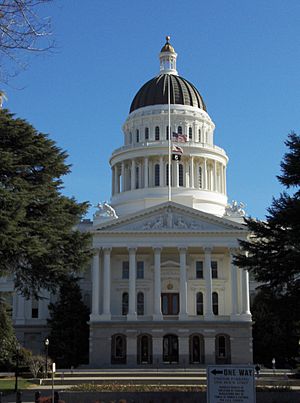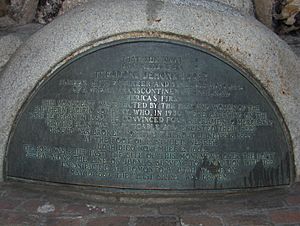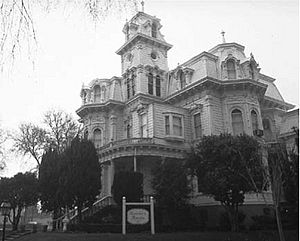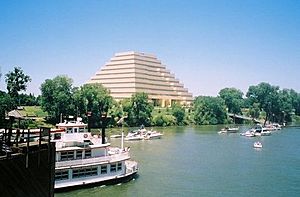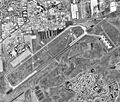History of Sacramento, California facts for kids
The history of Sacramento, California, began when it was founded in 1848. It was started by Samuel Brannan and John Augustus Sutter, Jr. near a dock built by his father, John Sutter, Sr.. This dock was located where the American and Sacramento Rivers meet.
Sacramento got its name from the Sacramento River, which is on its western side. A Spanish cavalry officer named Gabriel Moraga named the river "Santisimo Sacramento" (Most Holy Sacrament), referring to the Catholic Eucharist.
Before Europeans arrived, the Nisenan Native American tribe lived in the Sacramento Valley area. The Spanish were the first Europeans to explore this region. Sacramento became part of the Alta California province of New Spain when Spanish explorers claimed Central America and the American Southwest. Many explorers thought the area wasn't good for settling. So, it remained mostly untouched by Europeans, except for some Russian colonies north of San Francisco Bay in the early 1800s.
When John Sutter arrived in Monterey in 1839, the governor, Juan Bautista Alvarado, gave him the land he wanted. Sutter then created New Helvetia. He ruled it with his own private army and had a lot of freedom from the new Mexican government.
The California Gold Rush began when gold was found at Sutter's Mill in Coloma in 1848. This mill was one of John Sutter, Sr.'s properties. Many gold seekers arrived, which caused problems for Sutter's New Helvetia. Trade started to grow around the dock he had built where the American and Sacramento Rivers met.
Sacramento City was founded in the area where Sutter had planned to build Sutterville. John Sutter, Sr. was frustrated and put his son, Sutter, Jr., in charge. Sutter, Jr. worked to organize the growing city. However, because of its location, the city often flooded. Fires also swept through the city. To fix these problems, the city raised its sidewalks and buildings. They also started using stronger materials like brick and stone instead of wood. Sacramento was chosen as the state capital in 1854.
Contents
- Early Sacramento: Before and During Sutter's Colony (1839-1848)
- Sacramento's Founding and Early Growth (1848-1860)
- From the Civil War to the 20th Century (1861-1900)
- Sacramento in the Early 20th Century (1901-1930)
- World War II and the Great Depression (1931-1945)
- Sacramento From 1946 to Today
- Images for kids
- Referenced works
Early Sacramento: Before and During Sutter's Colony (1839-1848)
Native American Life Before Europeans Arrived
Indigenous people like the Miwok and Maidu Indians were the first people to live in the northern Californian Central Valley. The Nisenan Maidu group were the main people living in Sacramento before Europeans came. These tribes were hunter-gatherers. They found nuts and berries and caught fish from local rivers for food. They did not grow crops.
First European Explorers in the Area
The first European in California was Juan Rodriguez Cabrillo, a Portuguese explorer sailing for Spain in 1542. Other explorers included Sir Francis Drake and Sebastián Vizcaíno. But no one had found the Sacramento Valley or the Golden Gate strait yet. That happened later, in 1808 and 1623, respectively.
By the mid-1700s, explorers like Juan Bautista de Anza and Pedro Fages had looked at the region. But none of them thought it was a good place to settle. Gabriel Moraga was the first European to enter the Sierra Nevada mountains in 1808. He named the Sacramento River, but he incorrectly mapped the rivers in the area. The Mexicans, who became independent in 1821, felt the same way as the Spanish. The area remained unsettled until John Sutter arrived in 1839.
John Sutter and New Helvetia
John Augustus Sutter arrived in Yerba Buena (which later became San Francisco). He had faced a big storm on his way from Sitka, Russian Alaska. Mexican officials sent him to Monterey, the capital. There, he asked Governor Juan Bautista Alvarado for land to build an "empire of civilization."
Alvarado needed to establish a presence in the Sacramento Valley. He saw Sutter's plan as a way to secure the valley without sending more troops. So, he gave Sutter the land, but only if Sutter became a Mexican citizen. Sutter agreed and began building Sutter's Fort in 1840. This fort became his main base.
New Helvetia was about 44,000 acres (180 km2) in size. In 1841, Sutter bought Ft. Ross from the Russians. This area is in present-day Sonoma County. He combined all of Ft. Ross's land with his holdings at Fort Sutter.
Sutter's New Helvetia was inside Mexican borders but had a lot of autonomy (self-rule). John Sutter ruled New Helvetia with complete power. He even named himself general of his own private army made up of Native Americans. Sutter hired both white people and Native Americans for many jobs and military tasks.
As New Helvetia grew, Sutter's military presence worried the Mexican government. Sutter often boasted about his strength, which made the Mexican government even more concerned. As New Helvetia's economy grew, Sutter built a ranch at the Nisenan village of Hok. He named it "Hock Farm" and used it as his personal retreat. By 1844, New Helvetia was considered a stable colony. It was the only place in Alta California that welcomed foreigners. The Donner Party, for example, aimed for Sutter's Fort during their difficult journey across the Sierra mountains in winter.
Sutter's "empire" began to fall apart when he supported the unpopular Governor Manuel Micheltorena. Micheltorena was soon overthrown by Alvarado and José Castro in 1841. Sutter was jailed, but not before Micheltorena gave him the Sobrante Grant, which added 88,000 acres (360 km2) of land to New Helvetia.
In 1845, Castro came to Sutter's Fort and offered to buy New Helvetia. Sutter said no, though he later regretted it. In 1846, the Bear Flag Revolt began. Americans in Sonoma were worried about growing Mexican hostility towards foreigners. They took the city by surprise and captured General Mariano Vallejo. The American rebels asked to use Sutter's prison to hold the captured Mexican officials. Sutter reluctantly agreed and raised the Bear Flag over his fort. However, he treated the Vallejos, whom he considered friends, as guests, not prisoners. While the "Bear Flaggers" fought the Mexican government, Sutter tried to return New Helvetia to normal. But without enough workers due to the revolt, productivity suffered.
The United States started the Mexican–American War in 1846 against Mexico. This happened after the U.S. took over the Republic of Texas, which Mexico had not recognized as independent. California, along with other territories, became part of the United States in 1848 with the Treaty of Guadalupe Hidalgo. So, Sutter's New Helvetia came under U.S. control.
John Sutter continued his business. In 1847, he sent his associate James W. Marshall to build a sawmill in the foothills of the Sierra Nevada, near Coloma. In January 1848, Marshall found a flake of gold at the site of Sutter's new mill. After testing it, he confirmed it was real gold. News of the discovery spread almost instantly. When the news reached San Francisco, many hopeful gold seekers rushed north to the Sacramento Valley. By mid-1848, these "Argonauts" flooded Sutter's land looking for gold.
The arrival of these gold seekers ruined Sutter's New Helvetia. They slaughtered his livestock, drove away Native Americans loyal to Sutter, and divided his land among themselves without his permission. Disappointed, Sutter put his son in charge of the fort's business and retired to Hock Farm.
Sacramento's Founding and Early Growth (1848-1860)
How Sacramento City Began
The true city of Sacramento grew around a dock, called the Embarcadero. This dock was at the meeting point of the American River and Sacramento River. John Sutter, Sr. had built it before he retired in 1849, after the gold discoveries at Sutter's Mill in Coloma.
John Sutter, Sr. had put his son, John Sutter, Jr., in charge. Sutter, Jr. saw that trade was growing at the Embarcadero and thought it was a good business chance. The port was used more and more by gold seekers heading east. Sutter, Jr. had military officers William H. Warner and William Tecumseh Sherman survey his father's land. They found a spot where he could build a new city. He designed the city with a grid of numbered and lettered streets to keep it organized.
Many businessmen were drawn to this waterfront location. These included Samuel Brannan, future California governor Peter Burnett, and George McDougall. However, Sutter, Jr. and George McDougall disagreed over land lease terms. This led to a "trade war" between Sutter's Sacramento City and McDougall's new base at Sutterville. Sutter, Sr., who had disagreed with many of his son's choices, took back control of his business. After Sutter, Jr. ended the competition, trade in the area favored Sacramento City.
Unlike other settlements of its time, Sacramento City did not have gambling houses or saloons until the summer of 1849. The city was free of these businesses for its first few months. Churches also appeared early. The Methodist Episcopalian pastor W. Grove Deal started the first church with regular services in May 1849. Catholic reverend Augustine Anderson arrived in 1850 and built a church in 1854. Jews founded a synagogue called Congregation B'Nai Israel in 1852. In 1849, Edward C. Kemble moved from San Francisco and started the city's first newspaper, The Placer Times.
Sacramento City did not have a formal government in early and mid-1849. Gambling businesses wanted to keep only the loose alcalde (mayor) government. But many residents wanted a more formal structure. By the fall of that year, the city's legal system was established by a large vote. The government of California had just reorganized into county units. Days after this, the California State Legislature officially recognized Sacramento with a charter in February 1850. Sacramento City later asked the Legislature to drop "City" from its name, which was also granted. By 1850, Sacramento had organized public transportation on the rivers and regular street maintenance. The settlement had become a settled community.
Challenges and Changes in the 1850s
In January 1850, a major flood badly damaged the city. Heavy rains had soaked the ground where Sacramento was built. The American and Sacramento rivers rose at the same time.
The flood had a big economic impact because goods at the Embarcadero were not secured and washed away. Sacramento rallied behind Hardin Bigelow. He led efforts to put in emergency measures to protect the city from another disaster. His work on building protective levees and dams earned him support, and he was elected the city's first mayor.
Bigelow's efforts helped prevent a second major flood in March 1850. In April of the same year, the city had its first big fire. A second fire in November destroyed many businesses. To respond to the growing fear of disaster, citizen volunteers started California's first fire protection group, called the "Mutual Hook and Ladder Company." The city adapted by using iron window shutters to reduce wind and make fires harder to spread.
October 1850 brought the ship New World. It carried news of California's admittance to the Union (becoming a state). It also brought the cholera epidemic. This disease killed between 800 and 1,000 people within three weeks, including many of the city's doctors. Nearly eighty percent of the population fled. Bodies were buried in mass graves in cemeteries.
People who sought land from 1848 onwards refused to respect Sutter's original land claims. They also didn't recognize the titles of speculators who sold the land at very high prices. These "squatters" wanted to claim Sutter's land as public property. They tried to find legal ways to make his land claims, and those of the speculators, invalid.
The push for "squatter's rights" led to the formation of a Law and Order Association among the squatters. Violence broke out on August 14, 1850. The Sheriff, McKinney, and three squatters died. This event became known as the Squatters Riot.
By 1852, Sutter's New Helvetia had completely fallen apart, and Sutter's Fort was abandoned. Sacramento's economy now relied on coins. The city had grown past its unstable Gold Rush "boomtown" phase and become a full community. The Embarcadero, which had driven Sacramento's growth, no longer solely determined if the city would survive.
In 1852, Sacramento's economy became more diverse. Pharmacies, law firms, brass foundries, and clothing shops lined the city streets. Companies also began to use the fish populations in the American and Sacramento Rivers, a resource Sutter had used. The Central Valley's ability to grow crops was also noticed. Wheat from Sacramento was often shipped to other countries.
However, the city caught fire on the night of November 2, 1852. Nearly 85% of the city was destroyed. Sacramento residents rebuilt the city with brick instead of wood, which was a fire hazard. A second fire in 1854 destroyed twelve newly rebuilt downtown blocks, including the city courthouse.
The California state government met in Monterey in late 1849. The capital was set in San Jose, but the government didn't like the location. Former Mexican general Mariano Guadalupe Vallejo promised a good capital city at Vallejo in 1852. Vallejo couldn't build the city well enough, so the government temporarily moved to Sacramento. After Vallejo failed again, he ended his contract with the state. The government moved to Benicia until Sacramento made a bid for the capital that the Legislature accepted in 1854. That same year, the state legislature voted to make Sacramento the permanent state capital. Construction on the California State Capitol began in 1860 and took fourteen years to finish.
In early 1855, Colonel Charles L. Wilson and Theodore Judah started work on the Sacramento Valley Railroad. This was the first railroad chartered west of the Mississippi River. A money crisis forced Wilson to leave the project. He was replaced by Joseph Libbey Folsom, who died in July and was replaced by C. K. Garrison. Difficulties continued, so the railroad's length was limited to the city of Granite City (later renamed Folsom), twenty-two miles away. After Judah finished the track in 1856, he asked the U.S. government for a transcontinental railroad. However, tensions over slavery in the east were more important than Judah's idea at the time.
From the Civil War to the 20th Century (1861-1900)
Sacramento During the Civil War Era
The California Republican Party was founded in Sacramento on April 18, 1856. When the American Civil War began, the city strongly supported the Union. However, the opposing side, the Confederate States of America, also had active supporters in the city. Sacramento's population worried about an invasion from Confederate Texas when Union troops stationed in the city were sent east for battle. Because of this, volunteers formed military defense groups in case an invasion happened.
To improve communication, the Pony Express came to Sacramento in 1860. This was the first way to send messages across the continent, connecting California to the eastern states. However, the Pony Express only lasted eighteen months. It became outdated when the First Transcontinental Telegraph arrived. By 1861, Sacramento was linked to telegraph lines across the continent.
December 1861 and January 1862 brought terrible floods that made the city's future uncertain. To solve this, residents agreed that more levee construction was needed. The city was divided on how much to raise the city's level. Some wanted to raise it just a few feet, while others wanted a significant raise to allow for basements in businesses. In the 1863 election, the height of the city became a main issue. A candidate who supported high-level grading won.
Earth was moved from a dangerous bend near the two rivers and used to raise city blocks in 1868. Until construction finished, the city's sidewalks were uneven because some buildings remained at the old level. After the filled areas settled, new streets had to be paved. The grading and paving were fully completed by 1873. This left the first floors of many buildings as basements, and the second floors became the new main floors. Today, this system of 19th-century basements is known as the Sacramento Underground.
Railroads and Economic Changes
While the city was being raised, Theodore Judah continued to ask for government grants to build a transcontinental railroad. He didn't get the support he wanted. Instead, he worked with Daniel Strong and created the Central Pacific Railroad plan. However, the Sacramento Valley Railroad removed him from its leadership, suspicious of his actions.
To get funding, Judah met with thirty Sacramento businessmen. Among them were the Big Four: Mark Hopkins, Jr., Charles Crocker, Collis P. Huntington, and Leland Stanford. Together, these four formed the Central Pacific Railroad of California in 1861. The American Civil War began, and President Abraham Lincoln approved the railroad without the Southern forces that would normally have opposed it. Construction began in downtown Sacramento on January 8, 1863.
By 1865, the growing Central Pacific company took over the Sacramento Valley Railroad. The original Western Pacific Railroad was bought in 1867 to connect Sacramento to Stockton. In 1868, the California Pacific Railroad Company started a "war" with the Central Pacific Railroad over control of Sacramento. This involved legal and other actions. As a result, the Yolo-Sacramento Bridge was built, the first bridge across the Sacramento River. The "war" ended when the California Pacific Railroad was absorbed into the Central Pacific Railroad Company. Railroad companies were very powerful in Sacramento during this time.
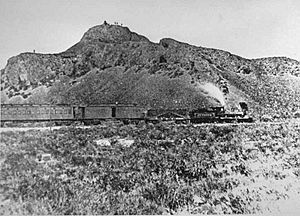
With the arrival of the railroad and refrigeration, wheat prices dropped. Fruit became a very important crop. From 1883 until the early 1900s, grain farms that had profited from wheat went out of business. The original owners died, and their heirs sold the land. This led to a land boom. New fruit farmers made hundreds of thousands of acres of farmable through irrigation.
However, the Chinese Exclusion Act in 1882 slowed Sacramento's agricultural growth. Despite anti-Asian feelings, many types of foreigners came to the city starting in the 1890s. These included Europeans from Italy, Portugal, and Croatia, as well as Japanese, Korean, Punjabi, and Filipino immigrants. Many of these immigrants joined the local Democratic Party.
Although schoolhouses had been in Sacramento County since 1853, Sacramento High School, the city's first high school, was founded in 1856. It taught subjects from English and math to astronomy and bookkeeping. The high school moved to a permanent location in 1887 as Sacramento's population grew rapidly. The high school administration opened twelve elementary schools across the city. Starting in 1894, individual schools in the city began to integrate (mix students of different races).
Sacramento in the Early 20th Century (1901-1930)
New Technologies and Social Changes
The automobile was introduced to Sacramento in 1900 at a local street fair. In 1903, the first car dealership opened. The next year, twenty-seven Sacramentans owned cars. The number of car owners grew very quickly after that. Cars made jobs involving horses and wagons less important. They also reduced the importance of the steamboat and railroad industries.
A series of Progressive politicians came to power in Sacramento's government. They put in place various reforms. Mayor George H. Clark worked to stop illegal gambling. He also passed a vote that reformed the city's government. This made the political power of each of the city's areas equal. This was to prevent one area, especially those with many working-class people, from becoming too powerful.
In 1907, the monopoly (complete control) that the Southern Pacific Railroad had over Sacramento was broken. The second Western Pacific Railroad asked for permission to build yards near the city. At the same time, women's rights activist L.G. Waterhouse, who led the Sacramento Women's Suffrage Association, worked for women's right to vote. Sacramentan women were granted the right to vote in 1911. This was almost nine years before the Nineteenth Amendment gave women the right to vote nationwide.
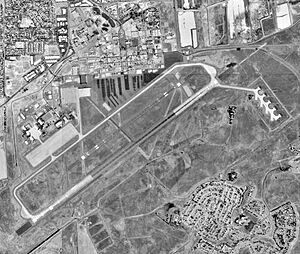
At the same time, the Mexican land grants of Rancho Del Paso and Rancho San Juan were sold to the public. These grants covered much of the northern parts of the county. People who invested in county development built the settlement of Citrus Heights on this land. Plans for communities like Orangevale, Carmichael, and Fair Oaks were set in motion. These new communities helped the city's reputation as a fruit production center. The city began to grow very quickly after the Sacramento government convinced the residents of East Sacramento and Oak Park to approve being annexed (joined). The three cities officially joined in September 1911. The first car-friendly settlement founded was North Sacramento, which was divided by Del Paso Boulevard.
Nearly 4,000 troops from Sacramento and other cities in the county went to fight in Europe's First World War. About 100 of those 4,000 died. The war also caused panic among the population. People became biased against Germans and anything related to Germany. Sacramento's Lutheran churches began to preach in languages other than German. A Council of Defense also looked for and punished signs of disloyalty to the American cause.
City tensions increased with the bombing of the governor's mansion in 1917. Suspects linked to the Industrial Workers of the World group were arrested and jailed, but never found guilty. When the war ended in 1918, the city celebrated the return of the 363rd Infantry regiment. President Woodrow Wilson also visited in 1919 to promote his League of Nations idea.
The American involvement in World War I in 1917 greatly increased demand for Curtiss JN-4 biplanes. A government contract led to the opening of Mather Air Force Base in the county. Sacramento came to rely on biplanes for continued economic growth until the end of the war. Extra military equipment, including biplanes, was used by the people of Sacramento. In 1929, farmers in the Sacramento area tried planting crops from the air. A growing public interest in aviation during this time was fueled by many air shows held around Sacramento.
In 1920, Sacramento adopted a new government system. It created nine positions on a new Sacramento City Council and a paid city manager position. This position was held by Illinois journalist Clyde Seavey. These changes limited the mayor's power and reduced the working class's control over city politics. Seavey strongly pushed for reform. He made businesses related to fortune-telling illegal and closed or refused to license local saloons and poolrooms. Seavey combined city departments to lower the city's budget.
In 1903, the Sacramento Solons, a minor league baseball team, began to play. The Solons played off and on in Sacramento between 1903 and 1976. After the Sacramento Solons team ended in 1976, Sacramento didn't have a minor league baseball team until 2000. That's when the Sacramento River Cats started playing at Raley Field in West Sacramento.
The Eighteenth Amendment started the Prohibition Era in the United States at the end of World War I. This meant alcohol was illegal. Northern Californian vineyards were major producers of American wines. The big loss in business forced many, including Sacramento's two largest vineyards, to close. The city was not very supportive of prohibition.
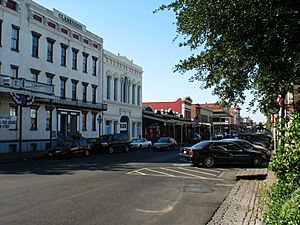
The events after World War I made the reformist Progressive movement less popular in the city. Hundreds of Sacramentans joined the local chapter of the Ku Klux Klan.
Sacramento became more connected with nearby cities like San Francisco, Chico, and Stockton as cars became more popular. The first bus route in the city opened between Sacramento and Folsom in 1910. Three years before that, a bond issue (a way to borrow money) allowed for the paving of roads connecting settlements in Sacramento County. Arthur Serviss Dudley, who was elected as the executive secretary of the Sacramento Chamber of Commerce, organized the Days of '49 festival in 1922. This was to encourage the city to work together for urban improvement. A 1915 plan to filter Sacramento's impure tap water passed. President Calvin Coolidge officially started the purification system from Washington, D.C. in 1923. That same year, Sacramento voters approved the creation of SMUD, or the Sacramento Municipal Utility District. This was a publicly owned utility company that competed with private companies.
Sacramento City College was founded in 1916. It is the oldest institute of higher education in Sacramento. It first met in rooms at Sacramento High School. A bond issue allowed them to build a new facility when Sacramento High School moved in 1924. The campus moved to its current location on Freeport Boulevard two years later. A grant also allowed the Sacramento City Unified School District to build six elementary schools in 1921.
World War II and the Great Depression (1931-1945)
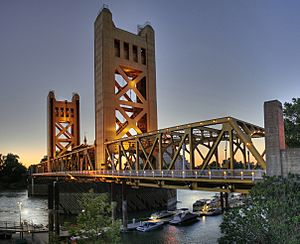
The Great Depression hit Sacramento along with the rest of the United States in 1929. By 1932, about 15,000 Sacramentans were unemployed. The local canning industry was affected first as demand for canned goods dropped. This led to layoffs. A freeze later destroyed half of the Sacramento area's citrus trees in December 1932.
"Hoovervilles," or large shantytowns built by homeless people without official permission, began appearing across the city. The city of Sacramento itself didn't have to deal with homeless people directly, as that was handled by the county government. However, since both relied on charities for their relief programs, most government-funded programs in the Sacramento area stopped when local charities began to collapse.
When relief money stopped, the county's unemployed people formed an Unemployed Council. They tried to pressure the Sacramento government to increase relief money. The city and county did not fully agree. Large groups of unemployed people stormed the Sacramento welfare offices in early and mid-1933. Many of those involved were labeled as communist or socialist and jailed.
A big loss in tax money led Sacramento to apply to President Herbert Hoover's Reconstruction Finance Corporation. While this helped some economic growth, Sacramento was mostly not involved with programs in Washington, D.C. until Franklin D. Roosevelt was elected president in 1932. New Deal programs greatly impacted Sacramento's economy. The State Employment Relief Administration and Public Works Administration approved loans for construction and jobs in the city.
Initially, long-distance travel was by train and steamship, while cars were used for local traffic. To help train and automobile traffic move west from downtown across the Sacramento River, the Tower Bridge was built in 1935. This bridge made travel easier between Sacramento and West Sacramento. The bridge was funded by the Works Progress Administration (WPA). The WPA also funded other projects, including 220 miles (350 km) of highway, 46 public buildings, and new runways at local airports.
Another economic boost came from the building of McClellan Air Force Base, which started in 1936 and finished in 1939. The previously closed Mather AFB also reopened in 1936. Additionally, the Sacramento Army Depot opened in 1942. By 1945, it became a major repair station for communications equipment under the Signal Corps.
Pearl Harbor, a military port near Honolulu, Hawaii, was attacked by surprise on December 7, 1941. McClellan AFB was active by 2 pm that day. Hundreds of B-26 Marauders and Curtiss P-40s were prepared for battle and sent to Alaska. Meanwhile, the city government made emergency plans. Mayor Thomas Monk increased security around public buildings and watched the levees on the Sacramento-San Joaquin Delta carefully. The city's first mandated blackout day was on December 8. Blackouts in Sacramento were not well organized until Sacramento County set up a system to inform residents when they would start and end. Rationing and saving resources greatly impacted Sacramento's economy. The federal government took 85% of retail profits for the war effort.
Executive Order 9066 was put into effect in February 1942. This order stated that "any and all persons may be excluded" from "military zones," which included the western Pacific Coast states and Arizona. A crackdown followed almost immediately. Japanese businessmen and workers were arrested, Japanese-owned businesses were closed, and Japanese financial assets were frozen. Internment processes (forced relocation to camps) followed one month later when Sacramento was placed into a military zone by Order 9066.
Sacramento From 1946 to Today

Sacramento's main university, California State University, Sacramento (also known as Sac State), was founded in 1947.
In 1966, Sacramento was the end point of a civil rights march by the United Farm Workers (UFW), led by Cesar Chavez. In the 1990s, Joe Serna, Sacramento's first Hispanic mayor, named a park in Downtown Sacramento after Chávez.
The Sacramento Kings NBA basketball team moved to Sacramento in 1985. They are currently Sacramento's only major professional sports team. However, the city is home to two professional minor league teams: Sacramento Republic FC and the Sacramento River Cats. A new arena for the Kings, Golden 1 Center, was built for the 2016-2017 NBA season. It seems to be bringing a new era of growth to Sacramento. Sacramento Republic FC is expected to get a MLS expansion bid and build a privately owned stadium in the railyards area.
Despite recent economic challenges, Sacramento is still growing very quickly. New homes continue to be built in the city and in rapidly expanding suburbs like Natomas, Elk Grove, Folsom, Roseville, Citrus Heights, Rocklin, and Rancho Cordova. One plan for the city's future suggests building a huge park in Downtown Sacramento called Gold Rush Park. This park would be as big as the largest city parks in the nation.
On April 3, 2022, a tragic event occurred in downtown Sacramento. Six people were killed, and twelve others were injured. The alleged gunmen are in custody awaiting trial.
Images for kids
Referenced works
- Starr, Kevin, California: A History. Modern Library, 2005.



